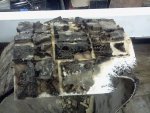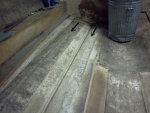The discussion of the pro's and con's of foam comes up on a regular basis, and I'm with WOG on this issue.
Foam gets blamed for things that the foam had nothing to do with. . . it just ends up holding the 'bag', or the water in the case of boat structure. If there were no foam in a boat's structure, there would still be water, if the boat was exposed to the same conditions and care that cause the foam to be wet. The only difference is that the water would be sitting there all by itself.
The water that finds its way into the chambers of a boats structure, foam or no foam, will still want to work its way through the fiberglass and into the wood. The water would much rather go to the wood than it would to the foam.
So, foam gets blamed for stuff that it really had nothing to do with. I'm sure we all experience that in our life times

To WOG's point, if you are to take a boat that had foam as part of its structural design and go without, you are really putting back about 1/2 of the structural strength. Foam does 2 things . . . it provides flotation and it provides strength . . . and in many cases lots of strength. So, those are the factors regarding foam that you should take into consideration in planning your restoration.
If you had a boat and its foam got wet after 4 years, then the structure would have gotten wet in those same 4 years without the foam. There probably was another issue at play there that the foam got blamed for . . .






















